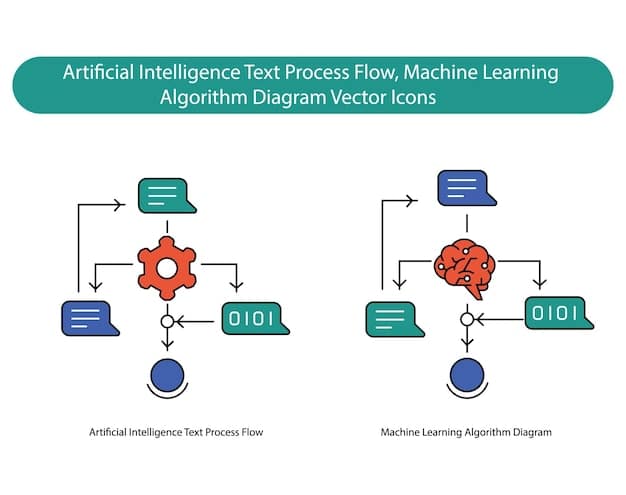The Role of AI in Business Automation: A Practical Guide for 2025

The Role of Artificial Intelligence in Business Automation: A Practical Guide explores how AI technologies like machine learning, natural language processing, and robotic process automation are transforming business operations by enhancing efficiency, reducing costs, and improving decision-making processes.
The landscape of business operations is rapidly evolving, and at the heart of this transformation lies the power of Artificial Intelligence (AI). This article, The Role of Artificial Intelligence in Business Automation: A Practical Guide, serves as a comprehensive roadmap for understanding and leveraging AI to streamline processes, boost productivity, and achieve unprecedented levels of efficiency.
Understanding the Fundamentals of AI in Business
Artificial intelligence (AI) is no longer a futuristic concept; it’s a present-day reality reshaping businesses across industries. To effectively leverage AI in business automation, it’s crucial to grasp the core principles and technologies that drive this revolution.
What Exactly is Artificial Intelligence?
At its simplest, AI refers to the simulation of human intelligence in machines. This involves creating systems that can learn, reason, solve problems, and make decisions, often without explicit programming.
Key AI Technologies Powering Automation
Several AI technologies are instrumental in enabling business automation. These include machine learning (ML), natural language processing (NLP), and robotic process automation (RPA).
- Machine Learning (ML): Algorithms that allow systems to learn from data without being explicitly programmed. ML models can identify patterns, predict outcomes, and improve their accuracy over time.
- Natural Language Processing (NLP): Enables computers to understand, interpret, and generate human language. NLP powers applications like chatbots, sentiment analysis, and language translation.
- Robotic Process Automation (RPA): Software robots that automate repetitive, rule-based tasks. RPA can mimic human actions to interact with digital systems and streamline workflows.
Understanding these fundamentals is the first step toward harnessing the transformative potential of AI in business automation.
Identifying Automation Opportunities in Your Business
Before diving into AI implementation, it’s essential to identify areas within your business that stand to benefit most from automation. A strategic approach to identifying these opportunities can yield significant improvements in efficiency and productivity.
Analyze Current Workflows
Begin by thoroughly analyzing your existing business processes. Look for tasks that are repetitive, time-consuming, and prone to human error. These are prime candidates for automation.
Areas Ripe for Automation
Several key areas within businesses often present significant automation opportunities. These include:
- Customer Service: AI-powered chatbots can handle routine inquiries, provide instant support, and escalate complex issues to human agents.
- Data Entry and Processing: RPA can automate the tedious task of data entry, reducing errors and freeing up employees for more strategic activities.
- Invoice Processing: Automating invoice processing can streamline accounts payable, reduce manual effort, and ensure timely payments.

By carefully assessing your business operations, you can pinpoint the areas where AI-driven automation can have the greatest impact.
Selecting the Right AI Tools and Platforms
With a clear understanding of your automation goals and target areas, the next step involves selecting the appropriate AI tools and platforms. The market offers a plethora of options, each with its own strengths and capabilities.
Evaluating AI Tool Capabilities
When evaluating AI tools, consider factors like the specific tasks they can automate, their ease of integration with your existing systems, and their scalability to accommodate future growth.
Popular AI Automation Platforms
Several leading AI automation platforms have emerged as frontrunners in the industry. These include:
- UiPath: A comprehensive RPA platform that enables businesses to automate a wide range of tasks, from data entry to complex workflows.
- Automation Anywhere: An AI-powered platform that combines RPA with cognitive automation capabilities, allowing businesses to automate tasks that require human-like decision-making.
- Microsoft Power Automate: A cloud-based platform that enables users to create automated workflows between various applications and services.
Selecting the right AI tools and platforms is a critical step toward achieving successful business automation.
Implementing AI Automation: A Step-by-Step Guide
Implementing AI automation requires a structured approach to ensure successful deployment and integration. This involves careful planning, execution, and monitoring.
Planning Your AI Implementation
Begin by defining clear goals and objectives for your AI automation project. Identify the specific metrics you will use to measure success and ensure that your implementation aligns with your overall business strategy.
Phased Implementation Approach
Consider a phased implementation approach, starting with smaller, less complex projects before tackling more ambitious initiatives. This allows you to gain experience and refine your approach along the way.
Integrating AI with Existing Systems
Ensure that your AI tools and platforms integrate seamlessly with your existing systems. This may require custom development or the use of APIs to facilitate communication between different applications.

By following a structured implementation process, you can minimize risks and maximize the benefits of AI automation.
Overcoming Challenges in AI Automation
While AI automation offers tremendous potential, it’s not without its challenges. Businesses may encounter obstacles related to data quality, talent acquisition, and change management. Addressing these challenges proactively is essential for successful AI adoption.
Data Quality and Availability
AI algorithms rely on high-quality data to learn and make accurate predictions. Ensure that your data is clean, consistent, and readily accessible to your AI systems.
Skills Gap and Talent Acquisition
Implementing and managing AI automation requires specialized skills. Invest in training programs to upskill your existing workforce or recruit talent with expertise in AI and related technologies.
Addressing Ethical Concerns
AI systems should be developed and deployed in a responsible and ethical manner. This includes addressing issues like bias, transparency, and accountability to ensure fair and equitable outcomes.
By addressing these challenges head-on, businesses can pave the way for successful AI automation.
Measuring the ROI of AI Automation
To justify investments in AI automation, it’s essential to measure its return on investment (ROI). This involves tracking key metrics and comparing the costs and benefits of AI implementation.
Key Metrics for Measuring ROI
Several key metrics can be used to assess the ROI of AI automation, including:
- Cost Savings: The reduction in operational expenses resulting from automation.
- Efficiency Gains: The increase in productivity and throughput achieved through automation.
- Error Reduction: The decrease in errors and defects due to automated processes.
- Customer Satisfaction: The improvement in customer service and satisfaction resulting from AI-powered solutions.
By carefully tracking these metrics and comparing them to the costs of AI implementation, you can gain a clear understanding of the ROI of your automation initiatives.
Demonstrating Value with Data
Use data to demonstrate the value of AI automation to stakeholders. Present clear and compelling evidence of the benefits achieved, such as cost savings, efficiency gains, and improved customer satisfaction.
By effectively measuring and communicating the ROI of AI automation, you can build support for future investments and drive continued adoption.
| Key Point | Brief Description |
|---|---|
| 💡 Automation Opportunities | Identifying repetitive, time-consuming tasks for AI implementation. |
| 🛠️ Selecting AI Tools | Evaluating and choosing the right AI platform for specific needs. |
| 📈 Measuring ROI | Tracking cost savings, efficiency gains, and customer satisfaction improvements. |
| ⚙️ Implementation | Step-by-step guide for deploying and integrating AI automation. |
Frequently Asked Questions (FAQ)
▼
AI in business automation refers to the usage of AI technologies like machine learning and NLP to automate tasks, enhance efficiency, and improve decision-making processes within a business setting.
▼
Tasks that are highly repetitive, rule-based, and data-intensive are most suitable for AI automation. Examples include data entry, invoice processing, customer service inquiries, and report generation.
▼
AI-powered chatbots can provide instant responses to customer inquiries, resolve common issues, and escalate complex cases to human agents, leading to faster resolution times and improved customer satisfaction.
▼
Challenges include ensuring data quality and availability, addressing the skills gap by training employees, integrating AI with existing systems, and addressing ethical concerns like bias and transparency.
▼
Success can be measured through key metrics like cost savings, efficiency gains, error reduction, and customer satisfaction improvements. These metrics provide a clear indication of the ROI of AI automation.
Conclusion
In conclusion, The Role of Artificial Intelligence in Business Automation: A Practical Guide, presents a clear path forward for businesses seeking to harness the power of AI. By understanding the fundamentals, identifying automation opportunities, and carefully implementing AI solutions, businesses can unlock significant efficiency gains, cost savings, and competitive advantages in the years to come.





